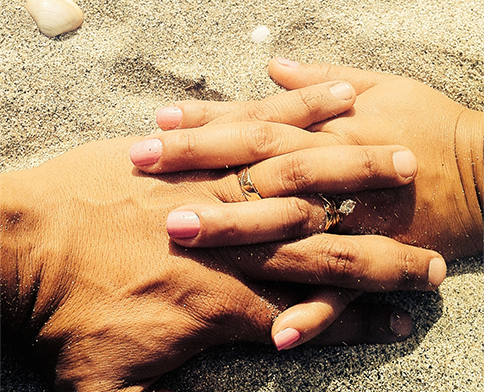If visiting the islands without sampling the fruit seems insane to you, you’re in the right place. Tasting weird fruit from around the world is my favorite. Maui has a lot to offer. These are the ones you’ll probably like the most.
Lilikoi is the Hawaiian Passionfruit. It’s yellow, unlike it’s purple cousin you may have seen in grocery stores. It’s sweeter and more flavor than what you’re used to, if you’re used to passionfruit at all. It’s a distinct flavor that you won’t forget. You can find the flavor on shave ice, in ice creams, in cocktails, pastries and other goodies – for a reason. Try one fresh if you can get your hands on one (or several!). Here’s a great article that shows you what they look like and gives a great explanation of what they are and how to integrate it in your cooking.
To eat it fresh, you can either bite the outside without squishing the fruit and try to crack it in half. You can also use a serrated knife to cut it in half. Don’t squish it! When you get it open, scoop out the yellow or orange juicy bits and eat it all whole, mashing it with your tongue. Don’t chew it. You won’t love the texture. The seeds are edible. Down the hatch!
Pro tips for selecting the very best lilikoi: find one that’s heavy, and when you shake it, makes ZERO sound. Older fruits will have drying-out innards and they aren’t as fresh, hence the shaking you don’t want. It’s ok if it’s wrinkly or has some bruisy spots on it so long as it’s heavy and makes no sound. If you can find one that’s cosmetically perfect, great, but it’s not necessary.
http://www.tastinghawaii.com/2012/01/lilikoi-hawaiian-passionfruit.html
If you’re upcountry on a hike toward the colder months of the year, you might get lucky and find banana passionfruit. It’s edible, and not as sweet as it’s hard, yellow cousin, but it’s SO refreshing when you’re been hiking for a while and you’re getting tired and/or thirsty!
https://en.wikipedia.org/wiki/Banana_passionfruit
Maui Gold Pineapple is the pineapple that’s grown in Hali’imaile (Ha-lee-ee-MY-lay) on the slopes of Haleakala. It’s exclusive to Maui and has some of the lowest acid you’ll find, therefore it’s easier on the tummy, easier on the inside of your mouth, and has a flavor you’ll never forget. Sniff the bottom to make sure you find one that smells like fresh, clean pineapple. If it smells like nothing, or smells like mold, keep shopping. Fun fact! If you fall in love with Maui Gold like I have and want to plant your own, you can! Twist off the crown, pluck off the leaves to leave about an inch of stalk exposed and put it in a glass of water for about three weeks, changing the water every few days. Soon you’ll have roots! Put it in the right kind of soil, and in about 2-3 years, you’ll get your very own pineapple at home.
If you want to ship some home, Kumu Farms has the best pricing you’ll find. https://kumufarms.com/collections/papaya-pineapple
Bonus pineapple find… if you can find it… The Kauai pineapple, the sugarloaf pineapple, is occasionally found at WholeFoods in Kahului. Lordy – it’s expensive (like $18 for one pineapple!), but it’s the best pineapple you’ll ever have in your whole life. It’s so sweet, so low-acid, and so tender that you can eat the core (and should). Savor every last bite. And yes, you can grow one of these too, using the same tips I just gave you. You’ll never be the same.
Good luck finding a fresh island Guava in the store. They’re so perishable (one day!) that it’s almost impossible. Not 100%, but damn close. Your best bet is when you’re hiking in the summer and fall and happen to visit one of the trails that has guava trees. You’ll know there’s fruit nearby when you can smell the rotting fruit that fell off the trees.
Do not – and I repeat – do not climb the trees. It’s not only disrespectful to the island, but the fruit isn’t even ripe or good to eat. Hunt on the ground for one that just fell. You’re looking for bright yellow, unblemished skin. Brush the dirt off, either rip it in half, or bite it. Eat the tasty cotton-candy pink innards, leave the firm yellow rind. It should not be hard, it should have the texture of a ripe banana. Seeds are edible.
https://specialtyproduce.com/produce/Pink_Guavas_8439.php
Strawberry Guava is another island treat you’ll find on hikes, if you’re super lucky and have a keen eye. Same rules apply as the yellow guava. Be careful you’re not eating poisonous stuff, ok? This one has a red outside, and lemony yellow inside. And yes, it tastes like strawberry and guava. It’s awesome!
https://specialtyproduce.com/produce/Strawberry_Guavas_8731.php
Canistel (or the Egg Fruit) is creamy, custardy and a pretty interesting little fruit. It’s got the texture of a baked sweet potato and the flavor is like a mix between a mango, banana, and a sweet potato. If you get lucky enough to find one at a fruit stand, grab it. It should have the firmness of the palm of your hand with relaxed muscles before eaten, in that it should have some fleshy “give” before you eat it.
https://en.wikipedia.org/wiki/Pouteria_campechiana
There are lots of other kinds of fruit you can try on the island and some are harder to find. If you’re at the local fruit stand and you see something you haven’t tried before, ask about it, try it and take the plunge! Ask what it is, how to eat it, when to eat it, and make sure you have time to eat it before you leave the island. No, you can’t take island fruit with you on the plane – only in your tummy!



